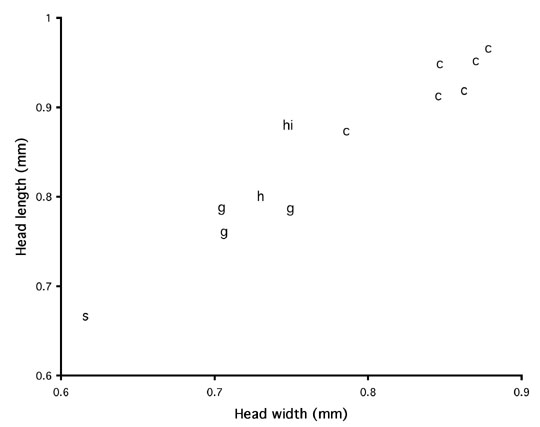Formicidae, Hymenoptera, Insecta, Arthropoda, Animalia
Additional images: worker, specimen JTLC000001521 (above images), alternate image of face (small, large); specimen CC011025-02, face view (small, large), lateral view (small, large); specimen HF010330-50, face view (small, large), lateral view (small, large); holotype worker, face view (small, large), lateral view (small, large), dorsal view (small, large), dorsal view showing epipetiolar carina (small, large), label (small, large).
Identification
Mandibles with large apical tooth, smaller subapical tooth, and series of 7-10 denticles of more or less uniform size; mandibles shiny, with large piligerous punctures; mandibles subtriangular, with well-differentiated basal and masticatory margins; clypeus evenly convex; occipital carina visible in face view; propodeal suture deeply impressed; propodeum swollen, evenly convex, with no trace of tubercles, no differentiation of dorsal and posterior faces; epipetiolar carina complete; ventral margin of postpetiole flat; color shiny black.
Range
Costa Rica, Panama, Brazil. Costa Rica: Turrialba (type locality), Penas Blancas, Pitilla, Barva Transect in Braulio Carrillo National Park.
Natural History
Several species of Megalomyrmex, including miri, silvestrii, symmetochus, and mondabora are specialized associates of small attines (Wheeler 1925, Kempf and Brown 1968, Brandao 1990, Adams et al. 2000, Adams and Longino 2007). Adams and Longino (2007) reported on the biology of Megalomyrmex mondabora. Most observations have been of M. mondabora nesting in the carton nests of Cyphomyrmex cornutus. Colonies of up to 260 Megalomyrmex workers occur in chambers in close proximity to the chambers of the Cyphomyrmex. Two colonies examined in their entirety by Adams were monogynous. Adams established small subcolonies with M. mondabora and C. cornutus and observed that the Megalomyrmex consume both the larvae and the fungus of Cyphomyrmex. The Cyphomyrmex workers appear to be submissive when contacted by Megalomyrmex workers.
Other material identified as M. mondabora has been collected with other attines. The types of M. mondabora, collected by W. L. Brown Jr., were found associated with workers of an unidentified Apterostigma (reported in Brandao 1990). Adams has collected M. mondabora with C. salvini, C. costatus, and Apterostigma goniodes (Adams and Longino 2007). There is variation in the size of M. mondabora, and the variation parallels the size of their hosts (Adams and Longino 2007) (Figure 1). Workers from smaller hosts are themselves smaller.

Figure 1. Head width versus head length for collections of Megalomyrmex mondabora. "c": host = Cyphomyrmex cornutus (one of the specimens is JTLC000001521 in Images above). "h": M. mondabora holotype, measurements from published description, host = Apterostigma. "hi": M. mondabora holotype, measurements from Automontage image. "g": host = Apterostigma goniodes (one of the specimens is HF010330-50 in Additional Images above). "s": host = C. costatus (specimen CC011025-02 in Additional Images above).
Selected Records:
During work at Pitilla station in Guanacaste Conservation Area, a mid-elevation wet forest site on the Atlantic slope of the Cordillera de Guanacaste, Scott Shaw pointed out to me a nest of Cyphomyrmex cornutus. It was a typical nest of accreted soil about half meter above ground. I noticed a number of Megalomyrmex mondabora workers moving on the surface, and entering through a hole. Dissection of the nest revealed a populous nest of Megalomyrmex, with brood and alate queens and males, in the center of the Cyphomyrmex next. The Megalomyrmex nest was completely surrounded by active portions of the Cyphomyrmex nest. On disturbance, there were occasional aggressive interactions between Cyphomyrmex and Megalomyrmex. There had been none (no aggressive interactions) prior to opening the nest.
In the Peľas Blancas Valley east of Monteverde I found workers on a log during night collecting.
On the Barva Transect in Braulio Carrillo National Park, at 500m elevation site, I found a typical suspended nest of Cyphomyrmex cornutus. It contained not only the Cyphomyrmex colony, but also a colony of Megalomyrmex mondabora. The Cyphomyrmex seemed to have one entrance hole and the Megalomyrmex another. I saw an occasional Megalomyyrmex worker on the surface of the nest. The Megalomyrmex colony was large, with perhaps dozens to a hundred or more workers, abundant brood, and alate queens and males. The Cyphomyrmex were also abundant, with many beetle elytra incorporated in nest and gardens. They did not seem to act aggressively toward the Megalomyrmex workers. [Images of nest, with associated Megalomyrmex colony (click here).]
Literature Cited
Adams, R. M. M., and J. T. Longino. 2007. Nesting biology of the arboreal fungus-growing ant Cyphomyrmex cornutus and behavioral interactions with the social-parasitic ant Megalomyrmex mondabora. Insectes Sociaux 54:136-143.
Adams, R. M. M., U. G. Mueller, T. R. Schultz, and B. Norden. 2000. Agro-predation: usurpation of attine fungus gardens by Megalomyrmex ants. Naturwissenschaften 87:549-554.
Brandao, C. R. F. 1990. Systematic revision of the Neotropical ant genus Megalomyrmex Forel (Hymenoptera: Formicidae: Myrmicinae), with the description of thirteen new species. Arquivos de Zoologia (Sao Paulo) 31:411-481.
Kempf, W. W., Brown, W. L., Jr. 1968. Report on some Neotropical ant studies. Papeis Avulsos Zool. 22:89-102.
Wheeler, W. M. 1925. A new guest-ant and other new Formicidae from Barro Colorado Island, Panama. Biol. Bull. Mar. Biol. Lab., Woods Hole 49:150-181.
Page author:
John T. Longino, The Evergreen State College, Olympia WA 98505 USA. longinoj@evergreen.edu